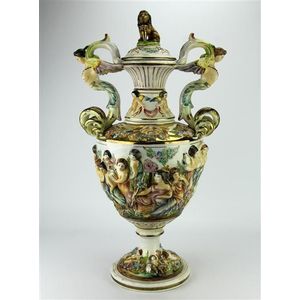Massive Fruit Decorated Classical Urns by R.H. Shuttlebotham
You must be a subscriber, and be logged in to view price and dealer details.
Subscribe Now to view actual auction price for this item
When you subscribe, you have the option of setting the currency in which to display prices to $Au, $US, $NZ or Stg.
- Gilding - Gilding is a method of ornamentation whereby a thin sheet of gold metal is applied to items made of wood, leather, ceramics, glass and silver for decorative purposes.
For furniture including mirrors, the sheet of gold is usually applied over a coating of gesso. Gesso is a mixture of plaster of Paris and gypsum mixed with water and then applied to the carved wooden frames of mirrors and picture frames as a base for applying the gold leaf. After numerous coats of gesso have been applied, allowed to dry and then sanded a coat of "bole", a usually red coloured mixture of clay and glue is brushed on and allowed to dry, after which the gold leaf is applied. Over time parts of the gilding will rub off so the base colour can be seen. In water gilding, this was generally a blue colour, while in oil gilding, the under layer was often yellow. In Victorian times, gilders frequently used red as a pigment beneath the gold leaf.
Metal was often gilded by a process known as fire gilding. Gold mixed with mercury was applied and heated, causing the mercury to evaporate, the long-term effect of which was to kill or disable the craftsman or woman from mercury poisoning. The pursuit of beauty has claimed many victims, not the least of which were the artists who made those pieces so highly sought after today. - Oviform /ovoid - The outline loosely resembling the shape of an egg.
- Campana Form Vases or Urns - A campana form vase or urn is a type of ceramic or metal container that is characterized by its reverse bell-like shape. The shape is typically wider at the top and narrower at the bottom, with a curved or flared opening at the top. The vase or urn may have a handle or handles on either side of the opening.The campana form was popular in ancient Greece and Rome, and the design has been revived in various forms throughout the history of art, including the Renaissance and the Art Nouveau period.
- Finial - An architectural decoration, found on the upper parts of of an object. On furniture they are usually found on pediments, canopies and shelf supports. On smaller ceramic or silver items, such as spoons, they may decorate the top of the item itself, or the lid or cover where they provide a useful handle for removal.
Finials have a variety of shapes and forms. They may be urn-shaped, baluster shaped round or spiral, but usually taper into an upper point. Many real life shapes may also be used as finials, such as pineapples, berries, pinecones, buds, lotus and acorns. Sometimes animals such as a lion are depicted, or fish and dolphins.
This item has been included into following indexes:
Visually similar items

Large Caverswall handpainted lidded urn, with fruit decoration signed D.Millar, height 50 cm

A Royal Worcester double handled urn vase, of ovoid form, the ivory ground ornamented with flowers, dragon handles, heightened in gilt, raised on square foot. Date code 1895, shape 1573, RN. 188127. Height 38 cm.

An impressive pair of Herend 'Rothchild' presentation vases and covers, painted with ornithological designs picked out in gilt, 51 cm high. Provenance: A private collection, Sydney

Capodimonte lidded figural urn with two mermaid figural handles, a lid modelled with an applied lion finial, raised putti figures to the neck, a relief of various classical ladies to the body below two Jupiter Ammon heads & various figures to the base. Sta
